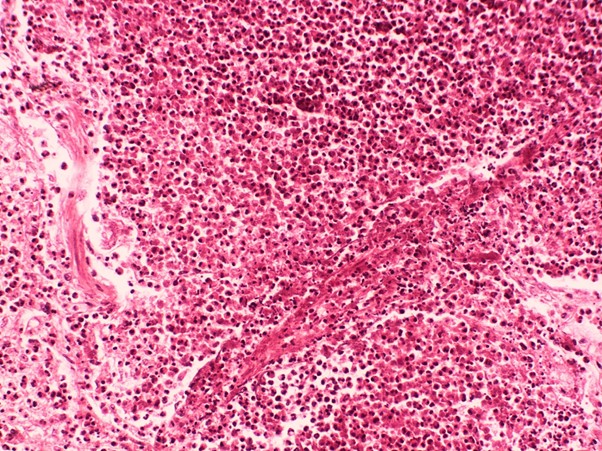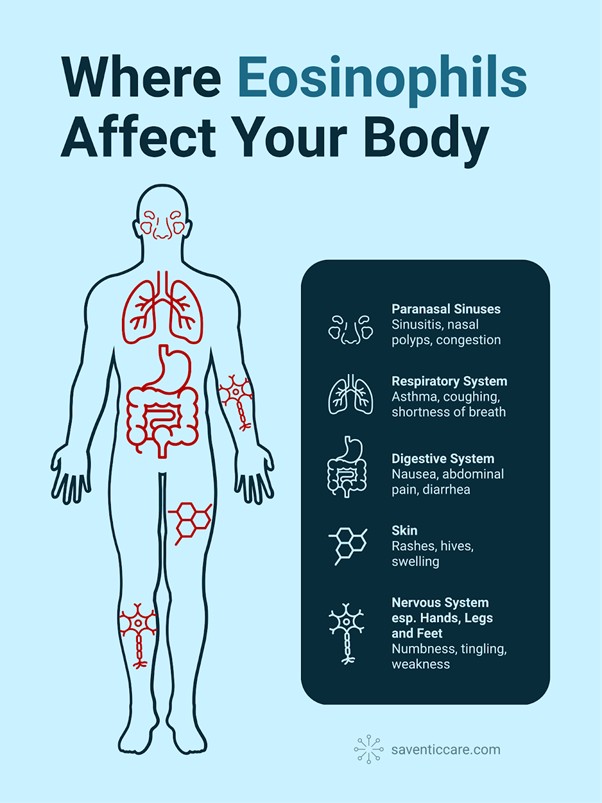Eosinofilia: ¿Qué puede significar un recuento elevado de eosinófilos?
Si recientemente le han diagnosticado eosinofilia, no está solo. La eosinofilia significa que tiene un nivel elevado de eosinófilos, un tipo de glóbulos blancos que participan en las respuestas inmunitarias. Aunque en algunos casos puede ser inofensiva, también puede ser un signo de algo más grave, como la GEPA (granulomatosis eosinofílica con poliangeítis), una enfermedad rara.
Este artículo explica qué es la eosinofilia, cuáles son los posibles síntomas y causas, y cuándo es conveniente realizar más pruebas.
¿Qué es la Eosinofilia?
Los eosinófilos son células del sistema Inmunológico que ayudan al cuerpo a reaccionar ante los alérgenos y a combatir ciertas infecciones, en particular los parásitos, según Kanuru y Sapra (2022). Normalmente, están presentes en pequeñas cantidades en la sangre. Cuando los niveles de eosinófilos superan las 500 células por microlitro — un estado conocido como eosinofilia —, puede ser señal de que el sistema Inmunológico está reaccionando de forma exagerada o lidiando con una afección oculta.
Si su recuento supera los 1500/μl, su médico puede recomendarle que se someta a más pruebas, especialmente si presenta síntomas.

¿Qué Significa un Recuento Elevado de Eosinófilos?
Un recuento elevado de eosinófilos significa que su sistema inmunitario está reaccionando a algo en su organismo. Esta reacción podría ser temporal o formar parte de un problema de salud más duradero.
Por sí solo, el número no proporciona un diagnóstico. Según VeryWell Health, los médicos observan cuán alto es el recuento, cuánto tiempo permanece elevado y qué otros síntomas se presentan. Comprender qué podría estar causando el aumento es el siguiente paso importante.
Posibles Causas: ¿Por Qué Están Elevados tus Eosinófilos?
La eosinofilia puede tener muchas causas posibles. Algunas son leves y desaparecen por sí solas, mientras que otras pueden requerir tratamiento o cuidados continuos.
Según Kanuru & Sapra (2022) las causas comunes incluyen:
- Condiciones alérgicas como asma, rinitis alérgica (como la fiebre del heno) o la dermatitis atópica
- Efectos secundarios de los medicamentos, especialmente de los antibióticos o los medicamentos para las convulsiones.
- Enfermedades infecciosas como infecciones parasitarias (por ejemplo, helmintos) o virales, dependiendo de la ubicación geográfica.
Las causas menos comunes incluyen:
- Enfermedades autoinmunes como GEPA
- Desórdenes crónicos inflamatorios
- Ciertos tipos de cáncer hematológico, como la leucemia.
- Otros tipos de cáncer, como el CTCL
En algunos casos, la causa no es evidente de inmediato. Cuando los síntomas están presentes y son persistentes, a menudo se necesita una evaluación más detallada para encontrar el problema subyacente.
Síntomas Que Podrías Notar
La eosinofilia suele desarrollarse sin síntomas evidentes al principio. Según informa VeryWell Health. Cuando aparecen los síntomas, suelen reflejar la zona del cuerpo en la que los eosinófilos están activos.
- Pulmones y vías respiratorias: asma, tos, dificultad para respirar, infecciones sinusales crónicas.
- Piel: erupciones cutáneas con picazón, urticaria, hinchazón.
- Sistema digestivo: dolor abdominal, náuseas, diarrea.
- Sistema nervioso: entumecimiento, hormigueo, debilidad muscular.
Si varios de estos síntomas se presentan juntos o no mejoran con los tratamientos habituales, la eosinofilia puede ser parte de un problema más amplio.

Asma, GEPA y Eosinofilia: Una Conexión Oculta
Para muchas personas, la eosinofilia aparece junto con el asma o problemas sinusales crónicos. En la mayoría de los casos, esto se debe a una inflamación alérgica. Pero si su asma empeora con el tiempo o no responde a los tratamientos habituales, y comienza a notar síntomas en otras partes del cuerpo, podría tratarse de una afección poco común.
Una de estas enfermedades es la GEPA (granulomatosis eosinofílica con poliangeítis)., una enfermedad autoinmune poco frecuente que afecta a los vasos sanguíneos pequeños y que a menudo comienza con asma y niveles elevados de eosinófilos. Tal y como se señala en las directrices basadas en la evidencia para la GEPA, Emmi et al. (2023): con el tiempo, puede provocar inflamación en los pulmones, la piel, los nervios y otros órganos.
👉 Más información sobre la GEPA y su relación con la eosinofilia.
Cómo Detectan los Médicos la Causa Subyacente
La Clínica Cleveland afirma que el diagnóstico de niveles inusuales de eosinófilos suele comenzar con un hemograma completo (CBC).. Si los eosinófilos están elevados, su médico puede sugerirle más pruebas, entre ellas:
- Repetir análisis de sangre
- Pruebas de alergia
- Análisis de heces para detectar parásitos
- Imágenes, como radiografías de tórax o tomografías computarizadas.
- Biopsias de tejido si se sospecha afectación de algún órgano.
El objetivo es comprender si los eosinófilos solo se encuentran elevados en la sangre o si también están activos en los tejidos.
Opciones de Tratamiento para Niveles Elevados de Eosinófilos
El tratamiento depende de la causa del aumento de eosinófilos. No existe un enfoque único que se adapte a todos los casos.
Los casos leves causados por alergias pueden responder bien a los antihistamínicos o inhaladores. Las infecciones se tratan con los medicamentos adecuados. Los casos más graves, como las enfermedades autoinmunes, pueden requerir corticosteroides, inmunosupresores o terapias biológicas, según Ahmad et al. 2025.
Obtener el diagnóstico correcto es el primer paso y el más importante antes de iniciar el tratamiento.
¿Cuándo Debe Hacerse un Chequeo Médico?
Debe considerar una evaluación más exhaustiva si:
- Sus niveles de eosinófilos siguen siendo altos.
- Tienes síntomas persistentes de asma o alergia que no responden al tratamiento
- Desarrollas síntomas nuevos o inexplicables, como fatiga, erupciones cutáneas o problemas nerviosos.
Revisión Gratuita de Riesgo de Padecer Enfermedades Raras
Si tiene eosinofilia u otros síntomas inexplicables que podrían estar relacionados con la GEPA u otra enfermedad rara, pruebe nuestra herramienta gratuita de evaluación de riesgo de enfermedades raras.
Solo tiene que diligenciar nuestro formulario para pacientes y analizaremos su caso con la ayuda de expertos médicos y herramientas basadas en inteligencia artificial.
- Seguro y confidencial
- Revisado por nuestro equipo de médicos
- El diagnóstico oportuno puede cambiar el curso de su afección.
👉 Empieza ahora tu evaluación de riesgos
Fuentes
- Kanuru, S. & Sapra, A. (2023). Eosinofilia. In StatPearls. StatPearls Publishing.
https://www.ncbi.nlm.nih.gov/books/NBK560929/ - Moawad, H. (2024). Eosinophilia – Causes, symptoms, and management. Verywell Health.
- Emmi et al. (2023). Evidence-Based Guideline for the diagnosis and management of eosinophilic granulomatosis with polyangiitis. Nature Reviews Rheumatology, 19, 321–335.
- Ahmad et al. (2025). Eosinophilic Granulomatosis with Polyangiitis (Churg-Strauss Syndrome). Medscape.
- Clínica Cleveland (2022). Eosinophils.
Preguntas Frecuentes
¿Qué significa que los niveles de eosinófilos sean altos?
Por lo general, significa que tu sistema inmunológico está respondiendo a algo. Puede ser algo leve, como una alergia, o algo más grave, como un trastorno autoinmune.
¿Cuál es un nivel alarmante de eosinófilos?
Un recuento superior a 1500/μl se considera significativo y debe evaluarse, especialmente si se mantiene elevado a lo largo del tiempo.
¿Los niveles altos de eosinófilos pueden causar cansancio?
Sí. La fatiga es un síntoma común cuando la eosinofilia está relacionada con inflamación crónica o afectación de órganos.
¿Cómo se trata el nivel elevado de eosinófilos?
El tratamiento depende de la causa. Puede incluir medicamentos para la alergia, esteroides o terapias inmunológicas para afecciones más complejas.